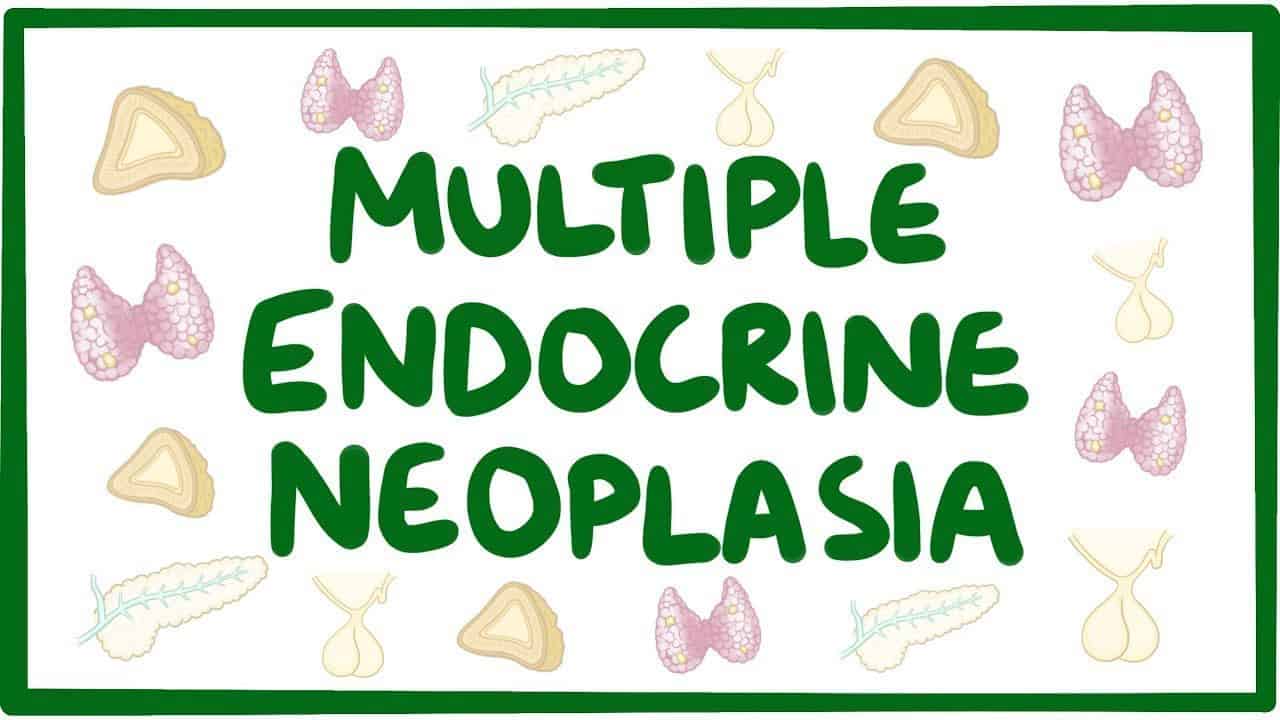WHAT IS MULTIPLE ENDOCRINE NEOPLASIA?
Multiple endocrine neoplasia, type 1 (MEN 1), sometimes known as Wermer’s syndrome, is an unusual disorder that causes tumors in the endocrine glands and parts of the small intestine and stomach. In MEN 1, the endocrine glands — generally the parathyroids, pancreas, and pituitary — grow tumors and release excessive amounts of hormones that could result in disease. Although, the tumors are generally non-cancerous (benign).
The excess hormones could cause a wide variety of signs and symptoms. These could involve tiredness, bone pain, broken bones, kidney stones, and ulcers in the abdomen or intestines. MEN 1 cannot be cured. But regular testing can find out problems, and doctors can provide treatment as required.
MEN 1 is a hereditary disorder. This means people who have the gene mutation could pass it on to their children. Each child has a fifty percent chance of getting the disorder.

SYMPTOMS
Signs and symptoms of MEN 1 are as follows:
- Tiredness
- Bone pain
- Broken bones
- Kidney stones
- Ulcers in the stomach or intestines
Symptoms are caused by the release of too many hormones into the body.
DIAGNOSIS
To diagnose multiple endocrine neoplasia, type 1 (MEN 1), your doctor will conduct a physical examination and check your medical history and family history. You might have a blood test and imaging tests, including the following:
- Magnetic resonance imaging (MRI)
- Computerized tomography (CT) scan
- Positron emission tomography (PET) scan
- Nuclear medicine scans
- Endoscopic ultrasound of the pancreas and other tests
Genetic testing might determine whether someone has a genetic mutation causing MEN 1. If someone has a mutation, his or her children are at risk of getting the mutation and developing MEN 1. Parents and siblings also are at risk of having the mutation though they have not yet developed any symptoms.
If no associated genetic changes are found in family members, then no further screening tests are required. Although, genetic testing does not uncover all MEN 1 genetic mutations. If genetic testing does not confirm MEN 1, but it is likely a person has it, that person and their family members still require close follow-up with appropriate blood and imaging tests.

TREATMENT
In MEN 1, tumors could grow on the parathyroids, pancreas, and pituitary gland. These tumors could lead to various conditions, all of which could be treated. These conditions and treatments might include:
- Pituitary tumors – These types of tumors might be treated with surgery or drug therapy.
- Hyperparathyroidism – Surgery to remove most of the parathyroid glands is the common treatment for too much parathyroid hormone.
- Neuroendocrine tumors – These are generally situated in the pancreas or small intestine (duodenum). Treatment depends upon the type and stage of the tumor.
- Hypoglycemic syndrome – This condition results when tumors produce too much insulin (insulinomas), causing severely low levels of glucose, which could be life-threatening. Doctors generally recommend surgery and possibly removal of a portion of the pancreas.
- Zollinger-Ellison syndrome (ZES) – ZES could result in tumors that overproduce gastric acid (gastrinomas), leading to ulcers and diarrhea. Doctors might prescribe medication or surgery.

- Other pancreatic neuroendocrine tumors – These tumors sometimes produce other hormones that could cause various health problems. Treatment of these types of tumors might involve medication, surgery, or an ablation procedure. In an ablation procedure, your doctor destroys abnormal tissue that might be present.
- Metastatic neuroendocrine tumors – Disease that has spread to the lymph nodes or liver might be treated with surgery. Surgery options include liver surgery, radiofrequency ablation, cryoablation, or chemoembolization.
Radiofrequency ablation uses high-frequency energy that passes through a syringe and causes the surrounding tissue to heat up, killing the nearby cells. Cryoablation includes freezing tumors. And chemoembolization includes injecting strong chemotherapy drugs directly into the liver. When surgery is not an option, doctors might use other forms of chemotherapy or hormone-based treatments. - Adrenal tumors – Most of these tumors could be observed and not treated. Although, if the tumors produce hormones or they are large and thought to be cancerous, doctors recommend removing them, generally with minimally invasive surgery.
- Carcinoid Tumors – Carcinoid tumors in people with MEN 1 could develop in the lungs, thymus gland, and digestive tract. Surgeons remove these tumors when they have not spread to other areas. Doctors might use chemotherapy, radiation therapy, or hormone-based therapy for advanced cases.

If you or anyone you know is suffering from multiple endocrine neoplasia, type 1 (MEN 1), our expert providers at Specialty Care Clinics will take care of your health and help you recover.
Call us on (469) 545-9983 to book an appointment with our specialists.
